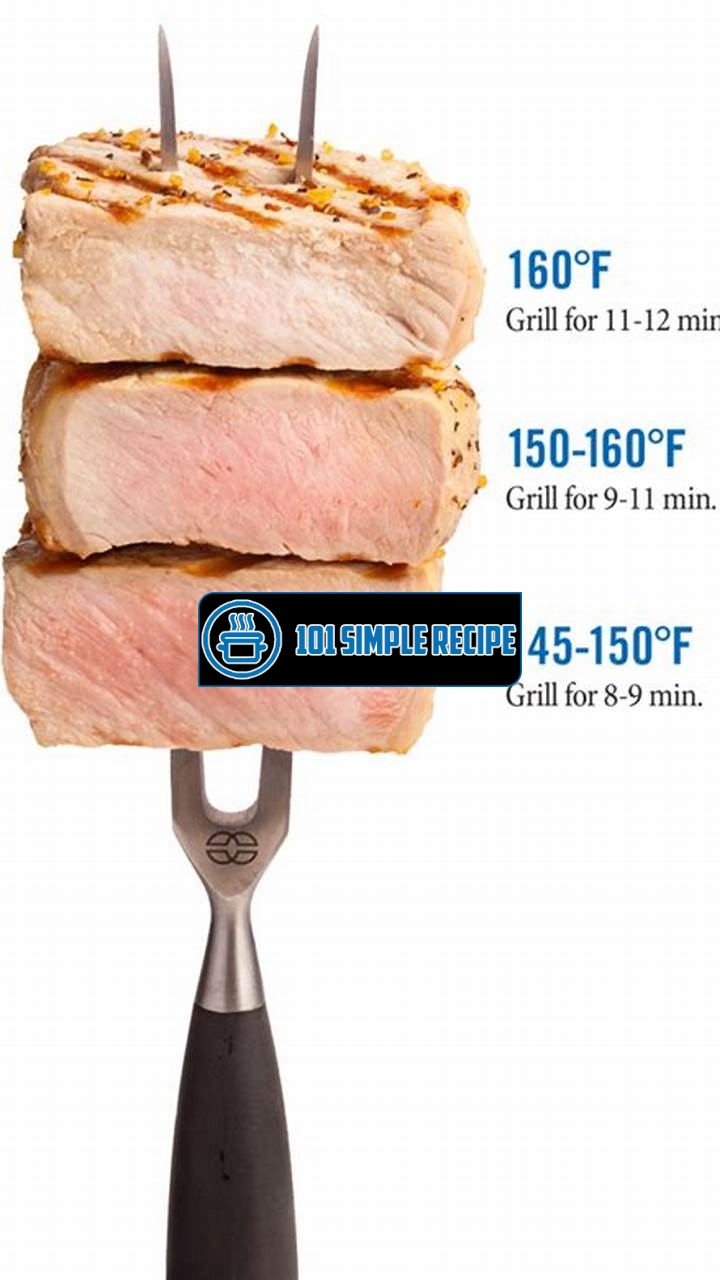Are you ready to become a master in the art of cooking pork roast? Look no further, because we have all the tips and tricks you need to achieve pork roast perfection. Whether you’re a novice chef or an experienced cook, mastering the art of cooking pork roast can elevate your culinary skills to new heights. In this article, we will guide you through the entire process, from selecting the right cut of pork to achieving that perfect juicy and tender texture. With our expert advice and step-by-step instructions, you’ll soon be impressing your friends and family with your delicious pork roast creations. So grab your apron and let’s get started! ️

The Importance of Pork Roast Internal Temperature
When it comes to cooking a pork roast to perfection, achieving the correct internal temperature is of utmost importance. Not only is it crucial for ensuring the safety of your meal, but it also plays a significant role in determining the deliciousness of the final product.
The Significance of Internal Temperature
The internal temperature of a pork roast is essentially the measure of how well the meat is cooked. It indicates whether the pork is safely cooked and free from harmful bacteria such as salmonella or E. coli. Consuming undercooked pork can lead to foodborne illnesses, which can range from mild stomach discomfort to more serious health complications.
Additionally, the internal temperature affects the tenderness and texture of the pork roast. By cooking the meat to the proper temperature, you can ensure that it is juicy and flavorful, making it a delight to savor.
How to Measure Internal Temperature
Measuring the internal temperature of a pork roast is simple and requires the use of a food thermometer. Here’s how:
- Insert the food thermometer into the thickest part of the pork roast, avoiding any bone or fat.
- Make sure the thermometer is placed deep enough to provide an accurate reading.
- Wait for a few seconds for the temperature to stabilize.
- Note the temperature reading on the thermometer display.
It’s important to remember that different cuts of pork may have varying recommended internal temperatures. For example, pork tenderloin should have an internal temperature of 145°F (63°C), while pork chops should reach 145-160°F (63-71°C) for optimal safety and taste.
Factors Affecting Internal Temperature
Several factors influence the internal temperature of a pork roast. Understanding these factors can help you achieve the desired doneness and ensure a consistently delicious result:
- The size and thickness of the pork roast: Thicker cuts will require a longer cooking time to reach the proper internal temperature.
- Starting temperature: Bringing the pork roast to room temperature before cooking will help ensure even cooking throughout.
- Oven temperature: Accurately setting and maintaining the oven temperature is crucial for cooking the pork roast evenly.
- Resting time: Allowing the pork roast to rest after cooking helps in redistributing the juices, resulting in a more tender and flavorful end product.
Note: It’s always recommended to refer to a reliable meat thermometer or cooking guidelines to determine the appropriate internal temperature for the specific cut of pork you are cooking. This will guarantee both the safety and taste of your pork roast.
By mastering the art of cooking pork roast to perfection, paying close attention to the internal temperature, and following proper cooking guidelines, you can create a mouthwatering dish that will impress family and friends alike. So remember, whether you’re a novice or an experienced cook, nailing the internal temperature is key to culinary success!
Recommended Internal Temperatures for Pork Roast
When cooking a pork roast, achieving the ideal internal temperature is crucial to ensure a tender and juicy result. Different types of pork roast require different levels of doneness to reach their peak flavor and texture. By understanding the recommended internal temperatures for different cuts of pork roast, you can master the art of cooking this delightful dish to perfection each and every time.
Internal Temperatures for Different Cuts
The internal temperature is a reliable indicator of how well-cooked a pork roast is. Here are the recommended internal temperatures for different cuts:
- Pork Loin Roast: To cook a tender and juicy pork loin roast, it is best to remove it from the oven when the internal temperature reaches 145°F (63°C). This will result in a slightly pink and moist center.
- Pork Tenderloin: For a succulent pork tenderloin, the internal temperature should read 145°F (63°C). This cut is lean and tends to dry out if overcooked, so it is important to follow the recommended temperature.
- Pork Shoulder Roast: The best internal temperature for a pork shoulder roast, also known as a Boston Butt, is 195°F (90°C). This allows the connective tissues to break down, resulting in a tender and flavorful roast.
- Pork Rib Roast: When cooking a pork rib roast, aim for an internal temperature of 145°F (63°C) for medium doneness. This will result in meat that is slightly pink near the bone, flavorful, and juicy.
- Pork Sirloin Roast: To achieve the perfect balance of tenderness and flavor, cook a pork sirloin roast until the internal temperature reaches 145°F (63°C). This will ensure a moist and delicious outcome.
Remember to always use a meat thermometer to check the internal temperature. The thermometer should be inserted into the thickest part of the roast, away from any bones. This will provide the most accurate reading.
Determining Doneness by Using a Meat Thermometer
A meat thermometer is an essential tool for any chef or home cook. When cooking a pork roast, using a meat thermometer is the most reliable way to determine its doneness. Follow these steps to ensure accurate and consistent results:
- First, insert the meat thermometer into the thickest part of the pork roast, making sure not to touch any bones.
- Wait for the thermometer to stabilize and display a reading. This may take a few seconds.
- Check the temperature indicated on the thermometer. Compare it to the recommended internal temperature for the specific cut of pork roast you are cooking.
- If the temperature has not been reached, continue cooking the roast and check the temperature again after a few more minutes.
By following these steps, you can ensure that your pork roast is cooked to perfection and safe to eat.
Common Mistakes to Avoid
While cooking pork roast, there are a few common mistakes that can negatively affect the final result. Avoid these pitfalls to achieve excellent cooking outcomes:
- Avoid overcooking the pork roast. This can result in dry and tough meat.
- Do not rely on cooking times alone. Use a meat thermometer to check the internal temperature accurately.
- Avoid cutting into the pork roast immediately after cooking. Let it rest for at least 10 minutes to allow the juices to redistribute and the temperature to equalize.
- Do not skip the step of using a meat thermometer. It is the key to achieving precise doneness.
Remember, mastering the art of cooking pork roast to perfection requires attention to detail and precision. By understanding the recommended internal temperatures for different cuts, using a meat thermometer, and avoiding common mistakes, you can elevate your pork roast cooking skills and create delicious meals for your family and friends.
Happy cooking! ️
Understanding the USDA Guidelines for Pork Roast Temperature
When it comes to cooking pork roast, achieving the perfect internal temperature is crucial. The United States Department of Agriculture (USDA) has established guidelines to ensure food safety and prevent any risks associated with undercooked pork. Understanding these guidelines and the reasons behind them is key to mastering the art of cooking pork roast to perfection.
Safe Minimum Internal Temperatures
The USDA recommends cooking pork roast to a minimum internal temperature of 145°F (63°C). This temperature ensures that any harmful bacteria present in the meat are destroyed, making it safe for consumption. Inserting a food thermometer into the thickest part of the roast without touching the bone will give you an accurate reading.
️ Tip: Monitor the internal temperature regularly to avoid overcooking.
However, certain cuts of pork, such as ground pork, need to be cooked to a higher internal temperature of 160°F (71°C) to ensure the elimination of any microbial pathogens. These pathogens, like Salmonella or E. coli, can cause foodborne illnesses if not properly cooked.
Risks of Undercooked Pork
Consuming undercooked pork can pose serious health risks. Pork may harbor various harmful bacteria, including Salmonella, Trichinella, and Toxoplasma, which can cause food poisoning and other illnesses.
The most significant concern when it comes to undercooked pork is the potential presence of Trichinella spiralis, a parasite that can cause a condition called trichinosis. This parasite can be destroyed by proper cooking temperatures, ensuring that the pork is safe to eat.
Note: Undercooked pork can lead to foodborne illnesses, so it’s important to follow the USDA guidelines.
The Dangers of Overcooking
While undercooked pork can be risky, overcooking can also have its downsides. Overcooked pork roast can become dry, tough, and chewy, resulting in a less enjoyable dining experience.
In addition to the texture issues, overcooking pork can lead to a loss of flavor and moisture. It’s essential to cook pork roast to the recommended internal temperature and ensure it rests before slicing to retain its juiciness and tenderness.
Tip: Resting the cooked pork for about 10-15 minutes allows the juices to redistribute, resulting in a more moist and flavorful roast.
By understanding the USDA guidelines for pork roast temperature, you can confidently cook pork roast to perfection every time. Remember to follow the recommended minimum internal temperature, be mindful of the risks of undercooked pork, and avoid overcooking to preserve the taste and texture of your delicious roast.
Tips for Achieving the Perfect Pork Roast Internal Temperature
When it comes to cooking a pork roast, achieving the perfect internal temperature is crucial. The internal temperature determines whether your roast is cooked to perfection, safe to eat, and bursting with flavor. In this article, we will share practical techniques and tricks to help you master the art of cooking pork roast to perfection.
Preparation Methods
Before you start cooking your pork roast, it is important to prepare it properly. Here are some preparation methods to ensure an excellent result:
- Brining: Brining your pork roast before cooking can help keep it moist and flavorful. Prepare a brine solution using water, salt, sugar, and any other desired spices. Submerge the roast in the brine for a few hours or overnight, then rinse it thoroughly before cooking.
- Seasoning: Season the pork roast generously with your favorite herbs, spices, and marinades. This will add depth of flavor to the meat and enhance its taste.
- Trussing: Trussing the pork roast with butcher’s twine helps it cook evenly and retain its shape. This is particularly important for larger cuts of meat.
Resting and Carryover Cooking
Resting the cooked pork roast before serving is crucial for a juicy and tender result. During the resting period, the internal temperature continues to rise due to carryover cooking. Here’s what you need to know:
- Resting Time: Allow the pork roast to rest for at least 15-20 minutes after it is cooked. This allows the juices to redistribute throughout the meat, resulting in a more flavorful and moist roast.
- Carryover Cooking: Keep in mind that the internal temperature of the pork roast will continue to rise by a few degrees even after it is removed from the heat source. To account for carryover cooking, it is recommended to remove the roast from the oven or grill when it reaches a temperature that is slightly below the desired doneness.
Note: The recommended internal temperature for a perfectly cooked pork roast is 145°F (63°C) as measured by a food thermometer inserted into the thickest part of the meat, avoiding the bone.
Recommended Cooking Times
While the internal temperature is the most reliable indicator of doneness, estimating the cooking time can also be helpful. Here are some recommended cooking times based on the weight and cut of the pork roast:
| Weight | Cut | Cooking Time |
|---|---|---|
| 2-3 lbs (0.9-1.4 kg) | Tenderloin | 20-30 minutes per pound |
| 4-5 lbs (1.8-2.3 kg) | Shoulder | 25-30 minutes per pound |
| 6-7 lbs (2.7-3.2 kg) | Leg | 20-25 minutes per pound |
It is important to note that these cooking times are just estimates and can vary depending on your oven or grill’s performance. Always use a food thermometer to ensure the pork roast reaches the recommended internal temperature.
By following these tips and techniques, you can master the art of cooking pork roast to perfection. Remember to brine, season, and truss the roast for optimal flavor and texture. Allow the cooked roast to rest before serving, and keep in mind the concept of carryover cooking. Finally, use recommended cooking times as a guide but rely on the internal temperature for determining doneness. Enjoy your deliciously cooked pork roast!
Common Questions About Pork Roast Internal Temperature
Are you tired of serving pork roast that is either undercooked or overcooked? Do you often find yourself unsure about whether it’s safe to eat pink pork? In this article, we will address these common questions about the internal temperature of pork roast to help you master the art of cooking this delicious dish to perfection. By understanding the proper internal temperature and learning how to fix undercooked or overcooked pork roast, you’ll be able to create flavorful and tender meals that will wow your family and friends.
Is It Safe to Eat Pink Pork?
Many people have been trained to believe that pork must be cooked until it is completely white and devoid of any pink color. However, this is not the case anymore. Thanks to advancements in pork production and safety measures, it is now safe to eat pork when it is slightly pink in the center. The United States Department of Agriculture (USDA) recommends cooking pork to an internal temperature of 145°F (63°C) with a three-minute rest time. This will ensure that harmful bacteria, such as Trichinella spiralis, are destroyed, while still allowing the pork to remain juicy and flavorful.
It’s important to note that ground pork, like ground beef, should always be cooked to an internal temperature of 160°F (71°C) to ensure proper food safety.
How to Fix Undercooked or Overcooked Pork Roast
Despite your best efforts, there may be times when you end up with an undercooked or overcooked pork roast. Don’t worry, there are ways to salvage your dish and still enjoy a delicious meal.
If your pork roast is undercooked, the best solution is to return it to the oven and continue cooking until it reaches the desired internal temperature. Use a meat thermometer to check the temperature periodically to ensure it doesn’t overcook. Additionally, you can slice the roast into smaller pieces and finish cooking them on the stovetop or grill.
On the other hand, if your pork roast is overcooked and has become dry, there are methods to bring back moisture and tenderness. One option is to slice the roast thinly and serve it with a flavorful sauce or gravy to help mask any dryness. You can also shred the overcooked pork and use it in dishes like tacos or sandwiches, where additional moisture can be added through sauces or toppings.
Can You Reheat Pork Roast?
Leftover pork roast can be enjoyed the next day by reheating it properly. The key to reheating pork roast is to do it gently, without further drying out the meat. Here’s how you can do it:
- Preheat your oven to a low temperature, around 250°F (120°C).
- Place the pork roast in an oven-safe dish and cover it with foil to retain moisture.
- Heat the pork roast in the oven for about 20 minutes or until it reaches an internal temperature of 165°F (74°C).
- Once heated, remove the pork roast from the oven and let it rest for a few minutes before serving.
Reheating your pork roast using this method will help ensure that it remains tender and juicy, just like it was when you first cooked it.
By mastering the art of cooking pork roast to perfection, you can elevate your culinary skills and create memorable meals for your loved ones. Remember to always check the internal temperature of your pork roast to ensure its safety, and don’t be afraid to experiment with different cooking techniques and flavors to achieve the desired results. Happy cooking!
Frequently Asked Questions
Thank you for taking the time to read our article on pork roast internal temperature. We hope you found it informative and helpful in your cooking endeavors. Should you have any more questions, please refer to the FAQs below:
| No. | Questions | Answers |
|---|---|---|
| 1. | What is the recommended internal temperature for a pork roast? | The recommended internal temperature for a pork roast is 145°F (63°C) followed by a three-minute rest. This ensures the pork is cooked to a safe temperature while remaining juicy and tender. |
| 2. | How long should I cook a pork roast to reach the recommended internal temperature? | The cooking time for a pork roast varies depending on its size and the cooking method used. As a general guideline, allow approximately 20 minutes of cooking time per pound of pork roast. Use a meat thermometer to check the internal temperature for precision. |
| 3. | Can I eat a pork roast if it’s slightly pink in the center? | It is safe to eat a pork roast if it’s slightly pink in the center, as long as the internal temperature reaches 145°F (63°C). The pink color in pork can be due to natural enzymes and does not necessarily indicate undercooking. However, if you prefer well-done pork, continue cooking until the internal temperature reaches your desired level. |
| 4. | What is the best way to ensure a juicy pork roast? | To ensure a juicy pork roast, it’s important to not overcook it. Use a meat thermometer to monitor the internal temperature and remove the roast from the oven or grill when it reaches 145°F (63°C). Let it rest for three minutes before slicing to allow the juices to redistribute. Additionally, marinating the pork roast prior to cooking can enhance its flavor and juiciness. |
| 5. | Are there any alternative seasonings for a pork roast? | Yes, there are various seasonings you can use to flavor your pork roast. Some popular options include garlic powder, rosemary, thyme, paprika, and cayenne pepper. Experiment with different spices and herbs to create your own unique flavor profiles. |
| 6. | Can I use a slow cooker to cook a pork roast? | Yes, a slow cooker can be used to cook a pork roast. Follow the manufacturer’s instructions for cooking times and settings. It’s important to ensure the internal temperature reaches 145°F (63°C) for food safety. Slow cooking can result in tender and flavorful pork roast. |
Thank You for Reading!
We hope this article provided you with valuable information on the internal temperature for cooking a pork roast. Remember to always use a meat thermometer to ensure accurate results and adjust cooking times accordingly. If you have any more questions or need further assistance, feel free to visit our website again later. Happy cooking!
Jump to Recipe
Pork Roast Internal Temp

Learn about the recommended internal temperature for cooking a pork roast and ensure safe and delicious results.
- 3 lbs pork roast
- 1 tsp salt
- 1 tsp black pepper
- 1 tsp garlic powder
- 1 tsp paprika
- Preheat the oven to 350°F (175°C).
- In a small bowl, mix together the salt, black pepper, garlic powder, and paprika. Rub this mixture all over the pork roast, ensuring it is evenly coated.
- Place the seasoned pork roast on a rack in a roasting pan. Roast in the preheated oven for about 2 hours, or until the internal temperature reaches 145°F (63°C).
- Remove the pork roast from the oven and let it rest for 3 minutes before slicing. This allows the juices to redistribute, resulting in a juicier roast.
- Slice the pork roast and serve it with your favorite sides. Enjoy!






